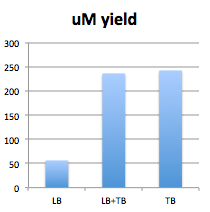Lidstrom:TB: Difference between revisions
No edit summary |
|||
| (3 intermediate revisions by the same user not shown) | |||
| Line 3: | Line 3: | ||
== Why TB? == | == Why TB? == | ||
Terrific Broth contains slightly more Bacto® Tryptone for amino acids than LB, but nearly 5x the Bacto® Yeast Extract, supplying large quantities of growth factors and nucleic acid precursors. TB also contains phosphate buffer to maintain a physiological pH during exponential growth and glycerol (which is not metabolized into lactic acid) at a non-rate-limiting concentration. Bacteria grow longer and lyse more slowly, increasing the amount of plasmid DNA recovered. Buffering tends to be needed if the media contains a carbon source, like glucose, which is turned into organic acids (acetate) in lieu of aerobic metabolism. Or if the carbon has to be rested from a typical nitrogen source, like protein (as in the case of Super Broth) which results in a pH rise as amines are stripped. Tris is a good buffer but typically a phosphate buffer system is used (although PIPES and MOPS are used in minimal media formulations). Giving a more readily available carbon source, like glycerol, would also enhance the media. ([http://biology-protocols.co.uk/index.php/Bacterial-Growth-Media-Recipes/terrific-broth.html source]) | Terrific Broth contains slightly more Bacto® Tryptone for amino acids than LB, but nearly 5x the Bacto® Yeast Extract, supplying large quantities of growth factors and nucleic acid precursors. TB also contains phosphate buffer to maintain a physiological pH during exponential growth and glycerol (which is not metabolized into lactic acid) at a non-rate-limiting concentration. Bacteria grow longer and lyse more slowly, increasing the amount of plasmid DNA recovered. Buffering tends to be needed if the media contains a carbon source, like glucose, which is turned into organic acids (acetate) in lieu of aerobic metabolism. Or if the carbon has to be rested from a typical nitrogen source, like protein (as in the case of Super Broth) which results in a pH rise as amines are stripped. Tris is a good buffer but typically a phosphate buffer system is used (although PIPES and MOPS are used in minimal media formulations). Giving a more readily available carbon source, like glycerol, would also enhance the media. ([http://biology-protocols.co.uk/index.php/Bacterial-Growth-Media-Recipes/terrific-broth.html source]) | ||
== Comparing TB to LB == | |||
[[Users:Janet B. Matsen|Janet]] did an experiment in 11/2014 comparing cell pellets of ACS grown in LB, 50% LB + 50% TB, and 100% TB. The conclusion is that '''1 part TB + 1 part LB is about as good as 100% TB, but LB is much worse.''' | |||
Evidence: | |||
* The LB pellet grew to a smalle final OD | |||
** Helen: enter data bout frozen culture ODs. And consider running SDS-PAGE. | |||
* The LB pellet gave substantially less ACS after purification. | |||
** | |||
[[image:.141111 experiment comparing LB_and_TB.png|upright=3.0|thumb|center|141111 experiment comparing LB, half TB, and all TB media for protein preparation. ([https://docs.google.com/spreadsheets/d/1FAHOmhxj7cuUzdOP5s8o_zoU_b0DFv35g5g5wCbxBG8/edit?usp=sharing source data])]] | |||
==Recipe: == | ==Recipe: == | ||
Latest revision as of 14:59, 24 November 2014
Return: Protocols
Why TB?
Terrific Broth contains slightly more Bacto® Tryptone for amino acids than LB, but nearly 5x the Bacto® Yeast Extract, supplying large quantities of growth factors and nucleic acid precursors. TB also contains phosphate buffer to maintain a physiological pH during exponential growth and glycerol (which is not metabolized into lactic acid) at a non-rate-limiting concentration. Bacteria grow longer and lyse more slowly, increasing the amount of plasmid DNA recovered. Buffering tends to be needed if the media contains a carbon source, like glucose, which is turned into organic acids (acetate) in lieu of aerobic metabolism. Or if the carbon has to be rested from a typical nitrogen source, like protein (as in the case of Super Broth) which results in a pH rise as amines are stripped. Tris is a good buffer but typically a phosphate buffer system is used (although PIPES and MOPS are used in minimal media formulations). Giving a more readily available carbon source, like glycerol, would also enhance the media. (source)
Comparing TB to LB
Janet did an experiment in 11/2014 comparing cell pellets of ACS grown in LB, 50% LB + 50% TB, and 100% TB. The conclusion is that 1 part TB + 1 part LB is about as good as 100% TB, but LB is much worse. Evidence:
- The LB pellet grew to a smalle final OD
- Helen: enter data bout frozen culture ODs. And consider running SDS-PAGE.
- The LB pellet gave substantially less ACS after purification.

Recipe:
- We use the OWW recipe: Terrific Broth
Ever wonder why we feed them glycerol, not glucose?
- Amanda Smith found:
- "Glycerol play the part of a cheap carbon-energy source for E.coli.
- Ecoli grown on glycerol excretes less acetate compared to e coli grown on glucose. (due to changes in the biochemical pathways and slower absorption rate of glycerol). Acetate is bad because it limits the growth of e coli. This is due primarily by methionine synthesis inhibition, which in turn disrupts protein synthesis and alters protein expression (A horror story if you are expressing proteins). Acetate also acidifies the media which also cause other changes in E coli physiology (such as reduced growth rate, altered K/Na ion and amino acid anions concentration. Which also has effects on protein synthesis)"
- So, I just read something that disagreed with the common knowledge that acetate limits E. coli growth and interferes with protein expression. Will post if I can find.
- "Glycerol play the part of a cheap carbon-energy source for E.coli.